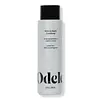What's inside
What's inside
 Key Ingredients
Key Ingredients

No key ingredients
 Benefits
Benefits

 Concerns
Concerns

 Ingredients Side-by-side
Ingredients Side-by-side

Water
Skin ConditioningStearyl Alcohol
EmollientParfum
MaskingCetyl Alcohol
EmollientTrichilia Emetica Seed Butter
EmollientCocos Nucifera Oil
MaskingButyrospermum Parkii Butter
Skin ConditioningBehentrimonium Chloride
PreservativePanthenol
Skin ConditioningDicaprylyl Ether
EmollientGlycerin
HumectantSimmondsia Chinensis Seed Oil
EmollientAdansonia Digitata Seed Oil
EmollientHydrolyzed Rice Protein
Skin ConditioningHoney
HumectantFicus Carica Fruit/Leaf Extract
Skin ConditioningAloe Barbadensis Leaf Juice
Skin ConditioningTocopherol
AntioxidantGlycine Soja Oil
EmollientTocopheryl Acetate
AntioxidantHydrolyzed Vegetable Protein Pg-Propyl Silanetriol
Skin ConditioningHydroxyethylcellulose
Emulsion StabilisingPropanediol
SolventPolysorbate 60
EmulsifyingDisodium Phosphate
BufferingCaprylyl Glycol
EmollientCaprylhydroxamic Acid
Benzoic Acid
MaskingWater, Stearyl Alcohol, Parfum, Cetyl Alcohol, Trichilia Emetica Seed Butter, Cocos Nucifera Oil, Butyrospermum Parkii Butter, Behentrimonium Chloride, Panthenol, Dicaprylyl Ether, Glycerin, Simmondsia Chinensis Seed Oil, Adansonia Digitata Seed Oil, Hydrolyzed Rice Protein, Honey, Ficus Carica Fruit/Leaf Extract, Aloe Barbadensis Leaf Juice, Tocopherol, Glycine Soja Oil, Tocopheryl Acetate, Hydrolyzed Vegetable Protein Pg-Propyl Silanetriol, Hydroxyethylcellulose, Propanediol, Polysorbate 60, Disodium Phosphate, Caprylyl Glycol, Caprylhydroxamic Acid, Benzoic Acid
Water
Skin ConditioningCetearyl Alcohol
EmollientGlyceryl Stearate
EmollientGlycerin
HumectantIsoamyl Laurate
EmollientBehentrimonium Chloride
PreservativeCocos Nucifera Oil
MaskingParfum
MaskingArtocarpus Heterophyllus Fruit Extract
Skin ConditioningHydrolyzed Rice Protein
Skin ConditioningCetrimonium Chloride
AntimicrobialCapryloyl Glycerin/Sebacic Acid Copolymer
Skin ConditioningGuar Hydroxypropyltrimonium Chloride
Skin ConditioningEthylhexylglycerin
Skin ConditioningDiheptyl Succinate
EmollientTetrasodium Glutamate Diacetate
Alcohol
AntimicrobialPhenoxyethanol
PreservativeWater, Cetearyl Alcohol, Glyceryl Stearate, Glycerin, Isoamyl Laurate, Behentrimonium Chloride, Cocos Nucifera Oil, Parfum, Artocarpus Heterophyllus Fruit Extract, Hydrolyzed Rice Protein, Cetrimonium Chloride, Capryloyl Glycerin/Sebacic Acid Copolymer, Guar Hydroxypropyltrimonium Chloride, Ethylhexylglycerin, Diheptyl Succinate, Tetrasodium Glutamate Diacetate, Alcohol, Phenoxyethanol
 Reviews
Reviews

Ingredients Explained
These ingredients are found in both products.
Ingredients higher up in an ingredient list are typically present in a larger amount.
This ingredient is a preservative and often used for it's anti-static properties. You'll most likely see this ingredient in hair conditioners.
It does not cause irritation or sensitization in leave-on products at 1-5%.
Cocos Nucifera Oil is obtained from the kernels of the coconut fruit. In other words, this is coconut oil.
Coconut Oil is rich in fatty acids with lauric acid making up the majority of these. It also contains linoleic acid. Due to this high fatty acid content, coconut oil helps trap moisture and soften skin.
Despite being antibacterial, coconut oil may not be great for acne-prone skin. It is comedogenic and may clog pores. This ingredient may not be safe for malassezia or fungal acne.
Note: Coconut Oil should not replace your sunscreen for UV protection. Studies show it only blocks about 20% of UV.
This oil is non-volatile and has a light scent.
The term 'fragrance' is not regulated in many countries. In many cases, it is up to the brand to define this term. For instance, many brands choose to label themselves as "fragrance-free" because they are not using synthetic fragrances. However, their products may still contain ingredients such as essential oils that are considered a fragrance.
Learn more about Cocos Nucifera OilGlycerin is already naturally found in your skin. It helps moisturize and protect your skin.
A study from 2016 found glycerin to be more effective as a humectant than AHAs and hyaluronic acid.
As a humectant, it helps the skin stay hydrated by pulling moisture to your skin. The low molecular weight of glycerin allows it to pull moisture into the deeper layers of your skin.
Hydrated skin improves your skin barrier; Your skin barrier helps protect against irritants and bacteria.
Glycerin has also been found to have antimicrobial and antiviral properties. Due to these properties, glycerin is often used in wound and burn treatments.
In cosmetics, glycerin is usually derived from plants such as soybean or palm. However, it can also be sourced from animals, such as tallow or animal fat.
This ingredient is organic, colorless, odorless, and non-toxic.
Glycerin is the name for this ingredient in American English. British English uses Glycerol/Glycerine.
Learn more about GlycerinHydrolyzed Rice Protein is protein extracted from rice. This ingredient is rich in antioxidants and peptides.
Studies show this ingredient may help with blocking the melanin creation process when skin is exposed to UV.
Parfum is a catch-all term for an ingredient or more that is used to give a scent to products.
Also called "fragrance", this ingredient can be a blend of hundreds of chemicals or plant oils. This means every product with "fragrance" or "parfum" in the ingredients list is a different mixture.
For instance, Habanolide is a proprietary trade name for a specific aroma chemical. When used as a fragrance ingredient in cosmetics, most aroma chemicals fall under the broad labeling category of “FRAGRANCE” or “PARFUM” according to EU and US regulations.
The term 'parfum' or 'fragrance' is not regulated in many countries. In many cases, it is up to the brand to define this term.
For instance, many brands choose to label themselves as "fragrance-free" because they are not using synthetic fragrances. However, their products may still contain ingredients such as essential oils that are considered a fragrance by INCI standards.
One example is Calendula flower extract. Calendula is an essential oil that still imparts a scent or 'fragrance'.
Depending on the blend, the ingredients in the mixture can cause allergies and sensitivities on the skin. Some ingredients that are known EU allergens include linalool and citronellol.
Parfum can also be used to mask or cover an unpleasant scent.
The bottom line is: not all fragrances/parfum/ingredients are created equally. If you are worried about fragrances, we recommend taking a closer look at an ingredient. And of course, we always recommend speaking with a professional.
Learn more about ParfumWater. It's the most common cosmetic ingredient of all. You'll usually see it at the top of ingredient lists, meaning that it makes up the largest part of the product.
So why is it so popular? Water most often acts as a solvent - this means that it helps dissolve other ingredients into the formulation.
You'll also recognize water as that liquid we all need to stay alive. If you see this, drink a glass of water. Stay hydrated!
Learn more about Water